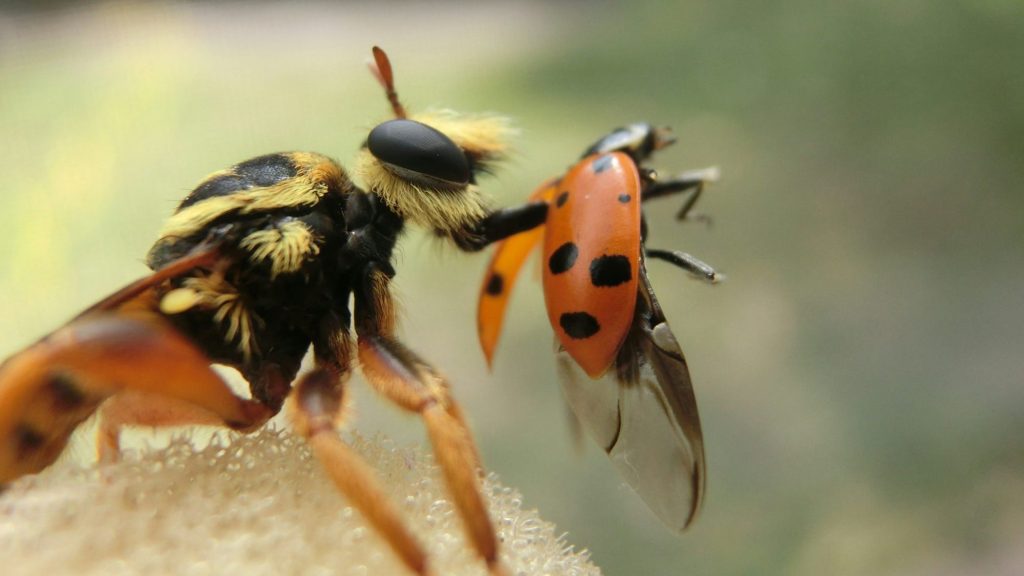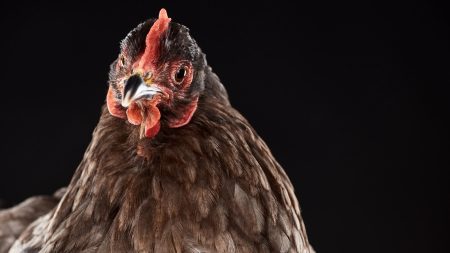This article was first published on The Conversation.
In April in the Florida Panhandle, the weather was hot, humid, and a thunderstorm was approaching. But as a recent graduate student, I was happy to escape from the harsh winter in Minnesota. I was with my mentor, Paloma Gonzalez-Bellido, working on a project that would become the focus of my Ph.D. research. Out in the scrubland, I kept a close eye out for an insect that likes shiny beads.
Laphria saffrana, or robber flies, are big black and yellow flies. Most of a laphria’s head is its large eyes, with a long, tubular mouthpart that can inject a powerful venom to immobilize prey quickly.
The photos Paloma showed me before we arrived were impressive, but not helpful for spotting the fly. There were insects flying in every direction, making it impossible to distinguish any details. I had only a split second to determine if what I was seeing was a laphria, a similarly colored yellowjacket wasp, or something else.
Despite their limited vision, the flies I was searching for are much better than me at spotting the insects they’re hunting. Somehow they’re able to focus on their preferred prey: beetles. Based on her observations in the field the previous year, Paloma believed they did this by looking for the flash of beetle wings.
If she was correct, laphria have come up with a clever method that balances speed, accuracy and specificity. Here are some of the clues we’ve uncovered to understand their success.
Pursuing the flash
Paloma had previously studied other predatory insects like dragonflies and killer flies. Their compound eyes don’t offer much detail about the visual world, making it possible to deceive them into chasing simple beads as if they were their prey insects.
But when Paloma attempted the same trick with laphria, they only went for the clear beads instead of the regular black ones.
The crucial difference between laphria and the other predators Paloma had studied is that they’re selective eaters. Their preferred prey is beetles. Therefore, Paloma and our colleague, Jennifer Talley, speculated that laphria are attracted to shiny beads because they reflect light and flicker like the clear wings of a beetle.
In Florida, we tested this theory by replacing the plain black beads with a panel of LED lights that we could set to flicker in sequence at a frequency matching the wing beats of beetles, which can range from 80 to 120 beats per second.
In an outdoor enclosure, Paloma placed previously captured robber flies one after the other on a log. Outside, Jennifer and I controlled the LED panel in front of the log and the high-speed cameras that recorded the activity.
The LED pixels flickered in sequence, mimicking a moving target. Laphria closely followed the lights only when they flickered at the same frequency as the wing flaps of beetles.
But even as our initial experiments started proving the idea, a new mystery came up. How do the flies accurately follow their prey?
Unique method to trace and recognize
Before they start chasing, all visual hunters, including laphria, must accurately follow their prey’s movements. Although many animals have this ability, what we discovered in laphria was, to our surprise, a slightly adjusted method compared with other hunters. Their approach allows them not only to accurately follow but also count those rapid movements from their prey’s wing actions.
When I observed the high-speed videos of laphria tracking the flashing LEDs and actual beetles, I noticed that they mainly moved their head in short bursts, called saccades, interspersed with little or no other movements. These saccades are extremely quick, lasting less than 40 milliseconds, and the time between them is only slightly longer. To the naked eye, this looks like continuous motion, but our high-speed videos show otherwise. The extent to which the flies moved their heads during each burst depended on the speed of the target and how far off center it was from the direction of the fly’s gaze.
What our findings informed us is that instead of continuously moving their heads to maintain the position of the target within the most sensitive parts of their eyes, laphria let it pass over their retina, moving only when it slips out of focus. We believe this approach helps them count the flashes of the prey’s beating wings, which determines their continued interest.
That is, the laphria know the wingbeat frequency of their most tasty prey and so pay attention to flashes that match. If the flash count matches their expectations, they will continue to track the target after it slips out of the sensitive zone of their eyes.
To bring it back into focus, though, they have to account for its speed and the position where they last saw it. Because the size of the saccade matches the speed of the prey, we think the laphria are keeping track of how fast the prey moves while at the same time counting the flashes from its wingbeats. So once a beetle slips out of focus, the predator knows how much to move its head to refocus.
Even though people track moving objects all the time–like while playing sports such as baseball or tennis or even just while watching a bird fly by–it’s a complicated process. It involves dynamic interaction between the visual and muscular systems.
Regardless of the motivation, the goal while visually tracking a target is the same–to focus the most sensitive zone of the eyes, known as the fovea, onto the item of interest. Laphria saffrana have seemingly modified that rule so they can learn more about the target. Their customized prediction strategy allows them to accurately locate and quickly chase down their very specific dietary needs.









